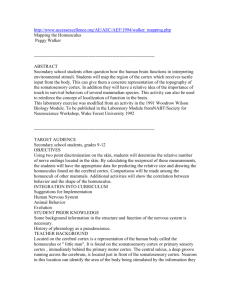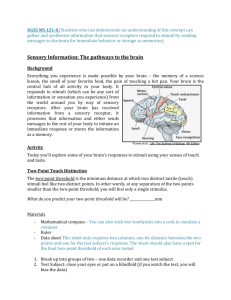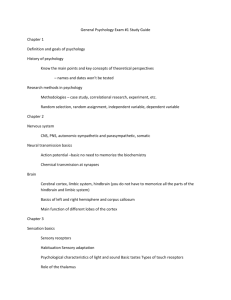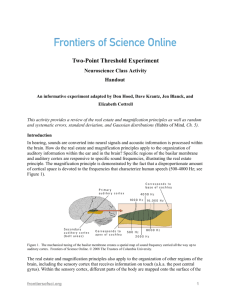Brain Maps – The Sensory Homunculus
advertisement
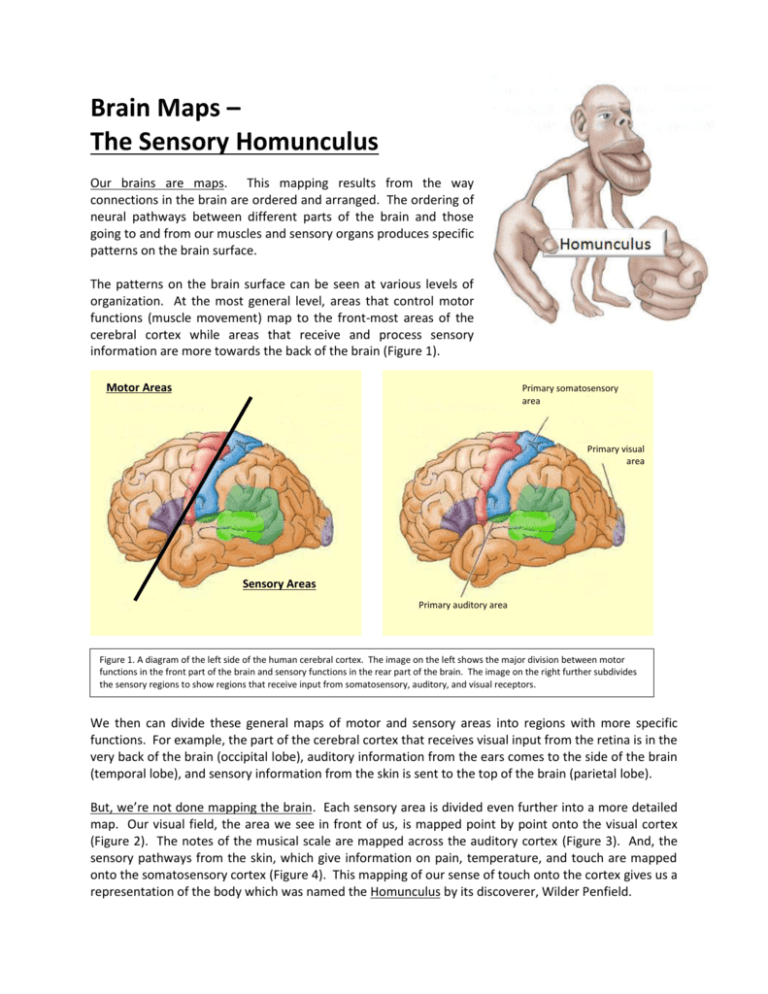
Brain Maps – The Sensory Homunculus Our brains are maps. This mapping results from the way connections in the brain are ordered and arranged. The ordering of neural pathways between different parts of the brain and those going to and from our muscles and sensory organs produces specific patterns on the brain surface. The patterns on the brain surface can be seen at various levels of organization. At the most general level, areas that control motor functions (muscle movement) map to the front-most areas of the cerebral cortex while areas that receive and process sensory information are more towards the back of the brain (Figure 1). Motor Areas Primary somatosensory area Primary visual area Sensory Areas Primary auditory area Figure 1. A diagram of the left side of the human cerebral cortex. The image on the left shows the major division between motor functions in the front part of the brain and sensory functions in the rear part of the brain. The image on the right further subdivides the sensory regions to show regions that receive input from somatosensory, auditory, and visual receptors. We then can divide these general maps of motor and sensory areas into regions with more specific functions. For example, the part of the cerebral cortex that receives visual input from the retina is in the very back of the brain (occipital lobe), auditory information from the ears comes to the side of the brain (temporal lobe), and sensory information from the skin is sent to the top of the brain (parietal lobe). But, we’re not done mapping the brain. Each sensory area is divided even further into a more detailed map. Our visual field, the area we see in front of us, is mapped point by point onto the visual cortex (Figure 2). The notes of the musical scale are mapped across the auditory cortex (Figure 3). And, the sensory pathways from the skin, which give information on pain, temperature, and touch are mapped onto the somatosensory cortex (Figure 4). This mapping of our sense of touch onto the cortex gives us a representation of the body which was named the Homunculus by its discoverer, Wilder Penfield. Figure 2 (left) The mapping pattern of the visual field from the retina to the primary visual cortex. Figure 3 (right) The mapping pattern of sound frequencies onto the primary auditory cortex. You may have noticed that these sensory maps of the brain do not map “areas” of sensation onto equivalent areas of cortical surface. For example, the small center our visual fields, the macula, is mapped onto a disproportionately large area of visual cortex. For the auditory cortex, the lowest 1,000 Hz in our hearing range covers as much area on the cortex as the upper 8,000 Hz. And finally, the homunculus on the sensory cortex looks barely human. It has a large representation of the face and hands compared with the torso, arms and legs. Why is this? The reason is the brain maps each sensory receptor onto the cortex rather than considering the area of the body where the sensor is located. The more Figure 4 The somatosensory Homunculus. receptors there are in a given area of skin, the larger that area’s map will be represented on the surface of the cortex. As a result, the size of each body region in the homunculus is related to the density of sensory receptors. To understand this concept, we can consider maps that we deal with more commonly. For example, which of the diagrams in Figure 5 show a map of the United States? The answer is “Both of them”. The Figure 5 The United States. Each area on the map represents either a certain area of land (left) or a certain number of people (right). map on the left was made by assigning each point on the map to a specific area of land on the surface of the earth. In this way distances on the map are proportional to distances on the ground. The most populated areas, the big cities, are represented by tiny dots while the great expanse of sparsely populated prairie, farmland and mountains becomes the largest part of the image. But what if we were interested knowing about the citizens rather than the geography of the U.S.? Then, instead of having each point on the map represent an area on the ground, we would make each point represent a person. Then the map of the US would look something like the one on the right. Now the area on this map is dominated by large population centers – the big cities, New York, Chicago, Miami, Los Angeles, etc. – and the great expanses of area in between the cities, where few people live, are reduced to narrow lines. Today’s Project Today you will explore brain mapping in a very personal way. Each of you will create your own individual homunculus. To do this, you first will make a tool to measure the density of touch receptors on your skin. Then, you will use this tool to estimate the receptor density on various regions of your body. From this, you will calculate how big each body region should be on your homunculus. The denser the receptors in a region, the larger the representation that body part will be in the brain, and the larger the body part picture you will choose. Finally, you will tape these body part pictures together to construct a model of the homunculus that is a map of your own somatosensory cortex. Skin receptor density will be measured with a two-point discrimination task. This is a technique that neurologists commonly use on patients to diagnose nerve injury. It is a subjective test, requiring the patient to report what they feel when softly touched on the skin by a pair of calipers with a specific spacing. The smallest distance between the points that the patient can accurately report as two points (the two-point discrimination threshold) reflects the density of touch receptors in that region of their skin; the smaller the two-point discrimination threshold, the higher the density of touch receptors. This project has three major steps. For each of these steps, refer to images provided at the end of this handout. What’s needed: Four 3” by 3” cardboard squares Twelve wooden toothpicks Metric ruler Tape Variously sized pictures of each body part with the longest dimension measuring 26 cm, 13 cm, 6.7 cm, 3.3 cm, and 1.7 cm. Alternatively, students can draw their own appropriately sized body parts. Step 1. Assemble two-point discrimination probes. 1.A. Tape one toothpick onto one of the 3” cardboard squares so that it extends beyond the edge of the cardboard by about 3 cm. 1.B. Measure perpendicular to the toothpick a distance of 6 cm from its center. 1.C. Tape a second toothpick parallel to the first one and separated by this distance. 1.D. Repeat the previous steps on the other three sides of the cardboard square with toothpick separations of 3 cm and 1.5 cm. On the fourth side of the square tape a single toothpick. 1.E. To keep the toothpicks secure, tape a second cardboard square over the first one to sandwich the toothpicks in between. 1.F. Make a second set of two-point discrimination probes using another pair of cardboard squares. Make one pair of toothpicks separated by 0.75 cm and another separated by 0.38 cm. On another side tape a single toothpick. Step 2. Measure the two-point discrimination threshold on various body parts. This task is done with a partner. One person is the examiner and the other is the subject. As an examiner, refer to the images at the end of the handout to find appropriate places to place the probes. 2.A. Have your subject close their eyes. 2.B. Softly place the 6 cm probe on one region of the body and ask the subject to report if they feel one or two points. Be sure that you give equal force to each toothpick. Orient the points parallel to the long axis of arms, legs, feet, and fingers. For the torso and head, orient the points horizontally. 2.C. Repeat 2.B. with increasingly smaller probe separations until the subject reports feeling a single point. The smallest distance the subject can accurately feel as two points is their two-point discrimination threshold for that body region. 2.D. As you sequentially test the subject with different probe separations, also try the single point from time to time and reassess the same separations to determine reliability and reproducibility of the subject’s responses. 2.E. Do not press hard enough to cause pain. The skin sensors for touch are different from those that report pain and temperature. These two types of sensation also travel to the brain by different neural pathways. 2.F. Record your data in the middle column of the table below. Body Region Head Torso Arms Hands Legs Feet Two-Point Discrimination Threshold in cm Body part dimension in cm Step 3. Construct your individual homunculus. 30 25 Size of Body Region (cm) 3.A. The two-point discrimination threshold for each body part is reciprocally related to with the size of the corresponding region in your homunculus (Figure 6). To make your homunculus a reasonable size, we calculate the size of the body part (in cm) equal to ten times the reciprocal of the two-point discrimination threshold (in cm). Thus, a two-point discrimination threshold of 6 cm corresponds to a body part that is about 1.7 cm long, and a threshold of 0.38 cm corresponds to a body part that is about 26 cm long. 20 15 10 5 0 0 For each of the body parts you measured, calculate the body part dimension using the graph in Figure 6 or the equation below. Put these numbers in the right hand column of the data table. 1 2 3 4 5 6 Two-point Discrimination Threshold (cm) Figure 6. Reciprocal relation between the two-point discrimination threshold and the size of the body region representation on the homunculus Body part dimension = 10 × (1/Two-point discrimination threshold) 3.B. Select paper body parts that are sized to correspond to the two-point threshold that you found for each. 3.C. Tape them together appropriately to construct your own homunculus. Step 1. Assemble two-point discrimination probes. 1.A. 1.B. 1.C. 1.D. 1.E. 1.F. 6 cm Single 3 cm Point 1.5 cm 0.75 cm Single Point 0.38 cm Step 2. Measure two-point discrimination thresholds on various body parts. HEA D FINGER LEG TORSO ARM FOOT Step 3 Construct your Individual Homunculus. Next Generation Science Standards that apply to these activities MS-LS1 From Molecules to Organisms: Structures and Processes MS- Gather and synthesize information that sensory receptors respond to stimuli by sending LS1-8. messages to the brain for immediate behavior or storage as memories. MS- Use argument supported by evidence for how the body is a system of interacting subsystems LS1-3. composed of groups of cells. Science and Engineering Practices Develop and using models Develop and use a model to describe phenomena Develop a model to describe unobservable mechanisms Planning and carrying out investigations Conduct an investigation to produce data to serve as the basis for evidence that meet the goals of an investigation. Disciplinary Core Ideas LS1.A: Structure and Function LS1.D: Information Processing Crosscutting Concepts Structure and Function HS-LS1 From Molecules to Organisms: Structures and Processes HS- Develop and use a model to illustrate the hierarchical organization of interacting systems that LS1-2. provide specific functions within multicellular organisms. Science and Engineering Practices Develop and using models Develop and use a model based on evidence to illustrate the relationships between systems or between components of a system Planning and carrying out investigations Plan and conduct an investigation individually and collaboratively to produce data to serve as the basis for evidence, and in the design: decide on types, how much, and accuracy of data needed to produce reliable measurements and consider limitations on the precision of the data (e.g., number of trials, cost, risk, time), and refine the design accordingly Disciplinary Core Ideas LS1.A: Structure and Function Crosscutting Concepts Systems and System Models Structure and Function References. This activity was adapted from the Homunculus Mapper developed by the Fitzpatrick Lab, Max Planck Florida Institute, http://www.maxplanckflorida.org/fitzpatricklab/homunculus/ Figure 1. Adapted from http://student.kc.school.nz/ClassWebs/SciWeb/Biology/Y13Bio/brain-diagram1.jpg Figure 2. http://www.utdallas.edu/~tres/integ/sen4/8_02.jpg Figure 3. http://www.sltinfo.com/wp-content/uploads/2014/01/tonotopic-organization.jpg Figure 4. http://www.intropsych.com/ch02_human_nervous_system/02homunc.jpg Figure 5 left. http://misterjogja.com/wp-content/uploads/2013/06/united-states-map-with-statenames-and-capitalssharpstowneng2--licensed-for-non-commercial-use-only--united-t7xor9a4.png Figure 5 right. http://forum.xcitefun.net/population-map-of-countries-world-map-3-t38131.html
